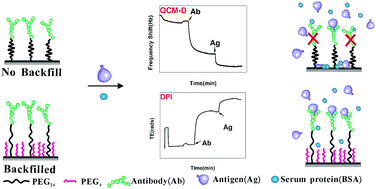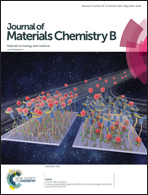A study of polyethylene glycol backfilling for enhancing target recognition using QCM-D and DPI
Abstract
Polyethylene glycol (PEG) is a promising candidate for protein resistance and preserving protein function in biomedical applications. In this study, a PEG-based bifunctional platform with antifouling for plasma proteins and high sensitivity for biomolecules was designed. Long PEG chains (PEG24) were used to install functional biomolecules, and short PEG chains (PEG4) served as a protective layer to backfill the surface and suppress nonspecific protein adsorption. Quartz crystal microbalance with dissipation (QCM-D) and dual polarization interferometry (DPI) were combined to investigate the dynamic process of PEG4 backfilling and the recognition capacity of biomolecules with different ratios of PEG4 and PEG24 in real time. The amount of PEG4 chain backfilling affected the flexibility of PEG24 and exposed sites. The recognition capacity was improved by increasing the ratios of PEG4 to PEG24. Therefore, when the feeding ratio of PEG4 to PEG24 was 9 : 1, a highly efficient and sensitive platform was constructed for immobilization of antibodies and recognition of antigens either in pure PBS or in a complex biological environment.



 Please wait while we load your content...
Please wait while we load your content...